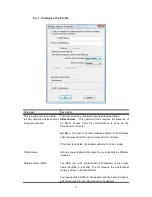
WPA2 802.1X
– Like WPA, WPA2 supports IEEE 802.1x/EAP
authentication or PSK technology. It also includes a new
advanced encryption mechanism using the Advanced Encryption
Standard (AES). AES is required to the corporate user or
government users. The difference between WPA and WPA2 is
that
WPA2 provides data encryption via the AES. In contrast, WPA
uses Temporal Key Integrity Protocol (TKIP).
WEP 802.1X
– It’s a special mode for using IEEE 802.1x/EAP
technology for authentication and WEP keys for data encryption.
Data Encryption
Disabled
– Disable the WEP Data Encryption.
WEP
– Enable the WEP Data Encryption. When the item is
selected, you have to continue setting the WEP Encryption keys.
TKIP
– TKIP (Temporal Key Integrity Protocol) changes the
temporal key every 10,000 packets (a packet is a kind of
message transmitted over a network.) This insures much greater
security than the standard WEP security.
AES
– AES has been developed to ensure the highest degree of
security and authenticity for digital information and it is the most
advanced solution defined by IEEE 802.11i for the security in the
wireless network.
Note: All devices in the network should use the same encryption
method to ensure the communication.
ASCII
WEP Key can be ASCII format. Alphanumeric values or signs are
allowed to be the WEP key. It is more recognizable for user.
Passphrase
It is a text string with a maximum of 32 alphanumeric characters,
for example: “Test“. The WEP Key is based upon the Passphrase
determined by you. This passphrase may not work with other
vendors’ products due to possible incompatibility with other
vendors’ passphrase generators. You must use the same
passphrase or WEP key settings for all wireless computers within
the network.
Key Index (advanced)
Select one of the four keys to be the data encryption key.
23
















































